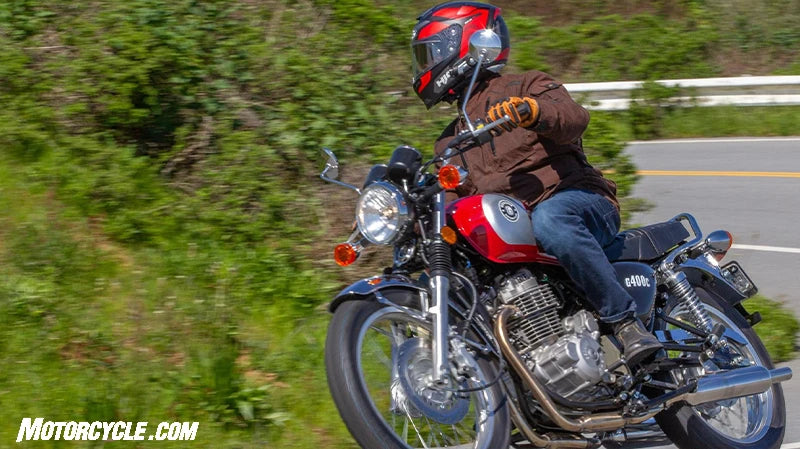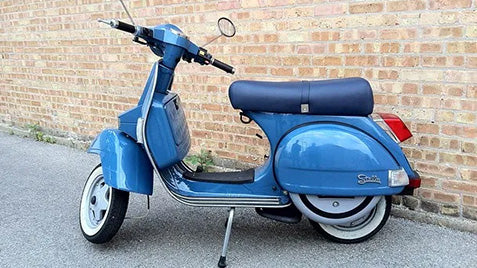Entry-level retro-bike perfection?
 Credit: Photos by Alan Lapp, <a href="http://levelfive.com/" target="_blank">Level 5 Design</a>
Credit: Photos by Alan Lapp, <a href="http://levelfive.com/" target="_blank">Level 5 Design</a>
One of my favorite leisure activities is to type an old-timey year, like 1980, into the Craigslist “Motorcycles for Sale” search box and see what pops up. Mostly, it’s either a lot of overpriced junk, overpriced “expert restorations,” or overpriced incomplete projects which are likely incomplete for very good reasons. A reliable, running bike at a reasonable price? Needle, meet haystack.
 Steel sidecovers and a kickstarter… must be a real moor’sickle.
Steel sidecovers and a kickstarter… must be a real moor’sickle.
So, what’s a cat with some cash and a hankering for a classic moto to do? He or she can buy a retro-style modern bike if Craigslist isn’t working out. Triumph’s Bonneville lineup, for instance, is a great choice and a great platform for customizing or just riding around. Or maybe the Ducati Scrambler? But what these bikes have in common is they’re big: big pricetags, big engines, and a lot of weight. All three of these bigs are intimidating to entry-level riders.
That’s why the Genuine Scooter Company, when it was time to bring a motorcycle into its lineup, decided to import its own version of entry-level retro-bike perfection. Designed by Honda, built by the Chinese and sold by a scooter company, the Genuine G400C combines retro styling, Japanese engineering, and Chinese value pricing. Does it deliver on all three things while still being fun to ride? Short answer: f–k yeah it does! Long answer? Read on.
First, some background. Back in the early noughts, Honda cranked out a cute lil’ retro-thumper called the CB400SS, working with a fledgling Chinese motorcycle company named Shineray to develop parts. When Honda stopped selling the 400 not long after, Shineray smelled an opportunity to sell its own version, upgraded with fuel injection and some other changes.
 Gabe’s just a handlebar mustache short of hipster-dom.
Gabe’s just a handlebar mustache short of hipster-dom.
It was around this time that the folks at Genuine scooters realized they should look into a product to sell to their customers looking to move “up” to a motorcycle, but then everything “went to hell,” according to Genuine’s Trey Duren, with the U.S. market shrinking to half its 2009 peak. But when things improved, Genuine was sitting pretty, one of the best-selling brands in the US with plenty of customers looking for something beyond the 50cc-170cc scoots Genuine stocked its many dealers with.
So, they got on the phone to Shineray, and the short version is that after four years, 31 major changes, and much bureaucratic wrangling with various regulatory agencies later, the G400C arrived in dealer showrooms last winter. Here’s what you get for an MSRP of $4,599.
Gaze upon the motor. Seem familiar? It should; it’s similar to the XR400R and other motorcycles based on that engine. That means it’s a 397cc air-cooled Single with a four-valve head, which is why it has swanky-looking dual stainless-steel exhaust headers: no, it’s not a Twin, you can tell your know-it-all riding buddies. Fuel injection is by Delphi, the same supplier for GM, Toyota, and Harley-Davidson, among others. The four-valve, five-speed mill is built for durability and long life, not racing; Genuine says the motor is EPA-rated at 26 horses and 22 lb-ft of torque. Doesn’t sound like much, but someone familiar with the XR400 and other powerplants from that family will tell you it has a lot of potential.
 G400C’s four-valve motor is as simple as it gets when it comes to maintaining it. You’ll learn a lot about motorcycle mechanics if you do the work yourself.
G400C’s four-valve motor is as simple as it gets when it comes to maintaining it. You’ll learn a lot about motorcycle mechanics if you do the work yourself.
It sits in a traditional chassis, a good thing for new riders. The semi-double-cradle tube-steel chassis puts 56 inches between the contact patches, with real spoke wheels and bias-ply, tube-equipped Kenda tires, 19 inches in front, and an 18-incher behind. The 31mm fork is non-adjustable; chrome dual shocks, adjustable for preload, locate the rear wheel. Braking is by 280mm disc and two-piston caliper in front, a good ol’ fashioned drum behind. No ABS for you. All in, we’re looking at a 353-pound package with the 3.4-gallon tank filled. Seat height is a mild and manageable 31 inches, and there’s a tachometer, speedo and the usual idiot lights, along with a twirly-knob-equipped tripmeter that you can set to “999” if you want to be reminded of the girls I met at Oktoberfest, or “888” if you want lots of luck.
Riding the G400C is just what you’d expect if you’re familiar with this kind of small, lightweight street-oriented Single. And the key word here is “familiar.” The Genuine has a very endearing way of feeling immediately familiar to anyone who gets on it, regardless of experience level. It’s light and small enough to feel like your MSF or CMSP training bike if you’re a new rider, but sturdy and responsive to feel like an actual vintage bike a veteran (my polite way of saying old A-F) rider may remember.
 If you miss your ’80s bike, no need: Here it is.
If you miss your ’80s bike, no need: Here it is.
As you’d expect, the seat is narrow and low to the ground, making it easy to get your feet flat on the ground, even if you’re pretty short; those shorter than 5-foot-3 may disagree. It’s also light and easy to handle at low speeds. I wouldn’t hesitate to recommend it as a training or first bike, because even though 400cc sounds like a lot to a new rider, this bike’s low power and predictable delivery make it easy to handle and hard to lose control of.
Starting it isn’t as easy as it should be. My demo unit required a little more cranking from the electric starter (suck it, Yamaha SR400!) than I thought it should, even when warm, and the kickstarter is a good thing to have as a backup. Still, it isn’t as easy as Fonzie made it look on TV. But that’s okay: the bike quickly settles into a quiet chatter, and the engine is responsive at low rpm, even when cold. I couldn’t find any fault with the Delphi fuel injection. This is a nice-running motor.
 We’ve complained about the SR400’s lack of cornering clearance; the G400C seems to have plenty.
We’ve complained about the SR400’s lack of cornering clearance; the G400C seems to have plenty.
It’s responsive and smooth but not fast. Engine vibes are noticeable, especially as you get towards redline: There’s no doubt you’re on a hard-working little thumper. The gearbox is old-timey, with a long gearshift throw and pronounced mechanical feel, but it’s also Honda smooth and easy to shift. Finding neutral should be easy enough for new riders coming from scooters. The clutch pull is so light it feels like it’s missing a spring or two, but the lever is kind of big and lacks adjustment, an issue for riders with smaller paws.
My main quibble with this motor is power, or lack of it. Put this guy on a dyno, and it’ll likely read around 22, corrected, at the rear wheel. Top speed, indicated, on flat and level ground is right around 80 mph. Add in a slight uphill slope with a headwind and it’s not quite 70 indicated. Carry a passenger? Not if you’re in a hurry. However, I’d bet a free-flowing exhaust and FI tuning would work wonders, and if my last experience race-tuning a similar motor wasn’t so disastrous, I’d be confident about building a 40 or even 50-horsepower screamer for not too much money or effort. I also want to point out that 22hp spanks that other Honda-derived paragon of beginner bikes, the Rebel 250, or the Suzuki TU250.
 Gabe testing the G400C’s autonomous mode for a possible future Uber product.
Gabe testing the G400C’s autonomous mode for a possible future Uber product.
Cruising on high-speed American interstates isn’t what this bike was built or designed to do, but you can do it. Just don’t be in a hurry and don’t carry too much stuff. Wind blast isn’t too severe, thanks to the medium-height bars, and comfort is good, with a sane rider triangle and wide, long seat (which starts getting hard after a few hours). The bias-ply tires tend to “hunt” on rain grooves, which depending on your experience level, can be charmingly nostalgic or nauseatingly unsettling.
Like most bikes of this ilk, it’s born for winding, peaceful two-lane roads. Keep the speeds below 65 and you’ll never feel like it’s too slow, and the light, easy handling, and torquey, responsive little thumper between your knees make you feel like Laurence of freakin’ Arabia. I love this bike on the bumpy, twisty, bicycle-plagued roads of West Marin in Northern California; they’re narrow and bucolic enough that you can imagine yourself in the Dorset countryside, exhaust cheerfully blatting away.
 The steel tank holds about 3.6 gallons of gas; more than enough for a long afternoon of riding.
The steel tank holds about 3.6 gallons of gas; more than enough for a long afternoon of riding.
The light, but controlled steering, predictable tires, and mild (yet sufficient) power delivery let you just pounce from turn to turn, smoothly brake, and pop-pop-pop down the straight. Ground clearance is better than you’ll likely need. The suspension is soft but surprisingly controlled (no wallowing, at least for this 155-ish pound rider), and the brakes do the job, though they’re not great. Push it hard, try to keep up with motos designed after 1990, and it will get out of shape; but you’re probably not that kind of rider.
Are you starting to get the idea that this review is all about “it does the job, but it’s not great?” Well, you’re right. I can’t call this motorcycle “great.” I can call it very good and a great first effort from Genuine, but this market segment has a lot of choices. Sure, the G400C rings in at $1200 less than the Yamaha SR400, $300 less than Royal Enfield’s more-authentic and not-much-slower Bullet 500, but it’s more money than Suzuki’s GW250 and doesn’t offer that much more performance. Spend an extra $200 and you can wrap your gloves around a Kawasaki Z400 ABS… with double the horsepower and much better handling, brakes, and suspension.
 Instruments are clear and well lit, if about 30 years out of date.
Instruments are clear and well lit, if about 30 years out of date.
But the targeted G400C buyer would no sooner consider a sportbike than he or she would consider a used Mazda Miata. That’s because a lot of entry – and re-entry – riders want that look, a classic-styled motorcycle they can customize and make their own. And that’s where simple, tube-frame, minimal-bodywork bikes like the G400C (and the SR400) crush the competition. The tank is steel, as are side panels and fenders. Spoked wheels, simple electrical system, unpolished, unpainted engine covers, easy-to-unbolt starter motor… it has the basic ingredients for a customization project, aided by a cottage aftermarket industry that’s sprung up around customizing Asian motorcycles over the last few years, not to mention Genuine’s busy lil’ accessory department, which offers clubman bars, performance shocks and other goodies.
 Webike, a Japanese aftermarket parts seller, offers this aluminum tank for $736 that looks good enough to eat, although it might not fit without some modding.
Webike, a Japanese aftermarket parts seller, offers this aluminum tank for $736 that looks good enough to eat, although it might not fit without some modding.
Pull up a full-size image of the G400C and give it a good eye-humping. What would you do with it? Café racer? Scrambler? Brat? Dirt-tracker? WWII courier bike? My dream has always been to have a small vintage-styled thumper that makes about 40 horsepower and weighs around 300 pounds, a bike that’s light and minimal and a blast to ride. At $4599, that’s a pretty low barrier to fulfilling a lifelong dream.
2019 Genuine G400C
+ Highs
- Looks really great
- Sensible first-bike choice
- A world of customization possibilities
– Sighs
- A little short on performance for the money
- Buzzy at high speeds
- Seat gets uncomfortable after a few hours
In Gear

Helmet: HJC IS-17 $199.95
Jacket: Aerostich Falstaff Jacket $667
Pants: Bull-It Jeans $200
Gloves: Joe Rocket Cafe Racer Glove $54.99
Boots: Aerostich Combat Lite Boots $347
| 2019 Genuine G400C Specifications | |
|---|---|
| MSRP | $4,599 |
| Engine | 4-stroke, Single-cylinder, SOHC, 4-valve, air-cooled |
| Displacement | 397cc |
| Bore x Stroke | 85.0 x 70.0mm |
| Compression Ratio | 8.8:1 |
| Fuel System | Delphi FI |
| Ignition | Electronic |
| Transmission | 5 speed |
| Final Drive | O-ring chain |
| Frame Type | Semi-Double Cradle, Tube Steel |
| Front Suspension / Wheel Travel | 31mm non-adjustable telescopic fork/TK inches travel |
| Rear Suspension / Wheel Travel | Coil-over twin shocks, adjustable for preload/TK inches travel |
| Front Tire | Kenda bias-ply, 100/90-19 |
| Rear Tire | Kenda bias-ply, 130/70 ZR18 |
| Front Brakes | Single 280mm disc with single two-piston caliper, no ABS option |
| Rear Brakes | 6.25-inch drum |
| Rake/Trail | 28 degrees/6 inches |
| Overall Length | 82.8 inches |
| Overall Width | 29.9 inches |
| Overall Height | 44.5 inches |
| Ground Clearance | 6.3 inches |
| Seat Height | 31 inches |
| Wet Weight | 353 lb (manufacturer claimed wet) |
| Fuel Capacity | 3.4 gallons |
| Fuel Economy | 70 mpg (claimed) 50 mpg (observed, mostly high-speed freeway) |
| Wheelbase | 56 inches |
| Colors | Black, Green or Red with Silver |
| Warranty | Two years, 24,000 miles |











Credit: Photos by Alan Lapp, <a href="http://levelfive.com/" target="_blank">Level 5 Design</a>



Leave a comment
This site is protected by hCaptcha and the hCaptcha Privacy Policy and Terms of Service apply.